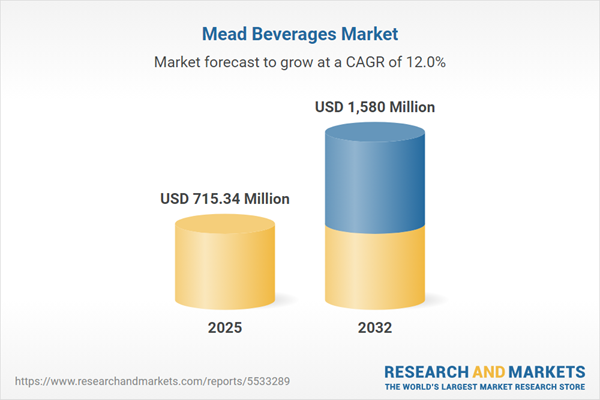Speak directly to the analyst to clarify any post sales queries you may have.
The mead beverages market presents expanding opportunities amid rising competition, swift regulatory transformation, and ongoing consumer demand for innovation. Senior leaders navigating this dynamic landscape require credible insights and actionable strategies to foster robust, resilient business growth.
Market Snapshot: Mead Beverages Market Size and Growth Outlook
The mead beverages market currently stands at USD 639.11 million with projections estimating it will reach USD 715.34 million by 2025, marking a compound annual growth rate (CAGR) of 12.01%. Looking further ahead, the sector is expected to surpass USD 1.58 billion by 2032. This expansion is propelled by a shift in consumer preferences toward unique beverage options, accelerated product innovation, and more impactful branding initiatives. Enhanced digital engagement is broadening market reach, empowering providers of mead beverages to transition from niche status to mainstream recognition in retail, hospitality, and direct-to-consumer spheres. These factors create a landscape where decision-makers can develop targeted, competitive growth strategies tailored to segment-specific needs.
Scope & Segmentation: Strategic View of the Mead Beverages Market
This report equips stakeholders with a comprehensive structure to guide decision-making in investment and operations within the mead beverages market. The segmentation and regional perspectives provide clarity and support on regulatory alignment and adaptation to distinct market trends:
- Product Types: Analysis includes fruit-based, spiced, and traditional meads, corresponding to the evolving preferences of consumers and research and development investments aimed at broadening product variety.
- Alcoholic Strength: Coverage spans from low-alcohol mead offerings, addressing moderation and health-conscious trends, to high-strength traditional varieties that appeal to legacy buyers and craft beverage enthusiasts.
- Packaging Formats: Considerations extend to bottled, canned, and kegged packaging, allowing producers to optimize positioning for retail shelves, hospitality venues, and event-driven opportunities.
- Distribution Channels: The market landscape includes offline retail, hospitality venues, online channels, direct-to-consumer approaches, and emerging subscription-based models to maximize customer reach and retention.
- Regions: The analysis covers the Americas, Europe, Middle East Africa, and Asia Pacific, each presenting distinct consumer behaviors, logistics factors, and unique regulatory frameworks impacting go-to-market approaches.
- Key Countries: Strategic insights focus on major markets in North and South America, Europe, Middle East, Africa, and Asia Pacific, with an emphasis on regulatory compliance and adaptation to local consumer dynamics.
- Leading Companies: Featured benchmarking of B. Nektar Meadery Inc., Moonlight Meadery LLC, Redstone Meadery LLC, and Schramm's Mead Company LLC, highlighting the role of innovation and operational standards in securing competitive performance.
- Technology and Analytics: The report details the use of digital analytics and real-time supply chain tracking to enhance operational agility, support informed resource allocation, and expand business intelligence capabilities in global markets.
Key Takeaways & Strategic Insights
- Emphasizing local sourcing of honey and botanicals meets sustainability criteria and strengthens brand authenticity, supporting procurement teams aligned with environmental goals.
- Implementing transparent ingredient sourcing and robust documentation across the supply chain boosts consumer confidence and eases compliance as regulatory frameworks advance.
- Integrating advanced production technologies unlocks new flavors and product lines, aiding market diversification and increasing appeal among both new adopters and established consumers.
- Leveraging interactive packaging, such as QR codes and augmented reality features, elevates digital engagement and adds value to both in-store and online shopping experiences.
- Driving cross-industry collaborations, particularly with research institutions and sector peers, accelerates innovation, enhances quality standards, and streamlines new product market introduction.
- Building visibility and trust through participation in local events and deploying compelling brand storytelling elevates regional presence and strengthens stakeholder engagement.
Tariff Impact & Trade Policy Implications
Recent adjustments to U.S. tariffs have notably influenced ingredient sourcing strategies and competitive positioning for mead producers. Increased duties on imported honey have reinforced the necessity for domestic procurement and diversification in sourcing. For organizations focused on export, staying agile and responsive to evolving trade policy is essential to maintain market access and defend competitiveness on the global stage.
Methodology & Data Sources
The findings in this report draw upon a robust methodology, integrating primary interview data, direct site assessments, supply chain consultations, and expert industry association input. Coupled with verified public information, this blended approach supports both data reliability and actionable guidance for executives assessing the mead beverages market.
Why This Report Matters for Industry Leaders
- Provides precise segmentation and comparative benchmarking to inform leadership on investment priorities and product strategy.
- Offers actionable direction on integrating digital innovation and operational best practices to adapt quickly as regulatory environments and buyer preferences shift.
- Prepares organizations to design agile, resilient supply chains capable of mitigating risks from evolving international trade dynamics and policy changes.
Conclusion: Strategic Outlook
Industry leaders who align targeted sourcing, technology adoption, and region-centric approaches position their organizations for resilient, sustainable growth as the mead beverages sector evolves.
Additional Product Information:
- Purchase of this report includes 1 year online access with quarterly updates.
- This report can be updated on request. Please contact our Customer Experience team using the Ask a Question widget on our website.
Table of Contents
3. Executive Summary
4. Market Overview
7. Cumulative Impact of Artificial Intelligence 2025
List of Figures
Companies Mentioned
The companies profiled in this Mead Beverages market report include:- B. Nektar Meadery Inc.
- Moonlight Meadery LLC
- Redstone Meadery LLC
- Schramm's Mead Company LLC
- Ithaca Hives Meadery LLC
- HoneyMoon Meadery LLC
- Vermont Mead Company LLC
- Savannah Bee Company Meadery LLC
- The Chaucer's Mead Company Ltd.
- Lyme Bay Cider Co Ltd
Table Information
| Report Attribute | Details |
|---|---|
| No. of Pages | 189 |
| Published | November 2025 |
| Forecast Period | 2025 - 2032 |
| Estimated Market Value ( USD | $ 715.34 Million |
| Forecasted Market Value ( USD | $ 1580 Million |
| Compound Annual Growth Rate | 12.0% |
| Regions Covered | Global |
| No. of Companies Mentioned | 11 |









